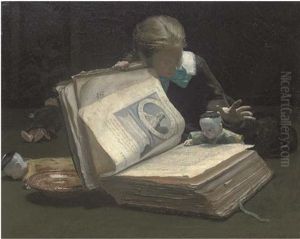Charles Lebayle Paintings
Charles Lebayle was a French artist born on March 13, 1856, in Bordeaux, France. He was a painter, sculptor, and illustrator whose work is often associated with the Symbolist movement, which flourished in Europe towards the end of the 19th century. Symbolism was characterized by its focus on emotions, ideas, and the representation of truths through metaphorical images rather than direct, realistic depictions.
Lebayle showed an early aptitude for art and received his initial training at the École des Beaux-Arts de Bordeaux. Later, he moved to Paris to further his education and career. In Paris, he studied under well-known figures such as academic painter Alexandre Cabanel and symbolist painter Gustave Moreau, both influential in shaping the young artist's style and technique.
In the 1880s and 1890s, Lebayle's work began to draw attention. He exhibited at various salons, including the Salon des Artistes Français and the Salon de la Rose+Croix, the latter being particularly associated with the Symbolist movement and its mystical and esoteric themes. His illustrations also appeared in contemporary literary and art journals, which played a crucial role in disseminating Symbolist aesthetics.
Lebayle's oeuvre includes allegorical paintings, portraits, and decorative pieces. His style is characterized by a refined use of color, sinuous lines, and often, a sense of melancholy or introspection. In addition to canvas paintings, Lebayle also created a number of decorative works for public and private commissions, which included murals and architectural sculptures.
Despite having a relatively successful career in his time, Charles Lebayle's name does not resonate as loudly as some of his contemporaries in the Symbolist movement, such as Gustave Moreau or Odilon Redon. Nonetheless, his contributions to the art of the late 19th century provide an important insight into the cultural and aesthetic shifts of the period.
Charles Lebayle's health declined in the later years of his life, and he passed away on May 2, 1938, in Paris. While he may not be a household name, his work is still appreciated by art historians and collectors who value the Symbolist period and its impact on the trajectory of modern art.



